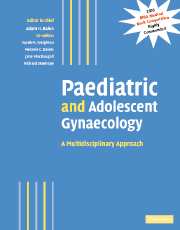Book contents
- Frontmatter
- Contents
- Contributors
- Preface
- Part I Normal development
- Part II Management of developmental abnormalities of the genital tract
- Part III Management of specific disorders
- 18 Disorders of growth and puberty
- 19 Turner's syndrome
- 20 Androgen insensitivity syndromes
- 21 Rokitansky syndrome and other Müllerian anomalies
- 22 The XY female
- 23 The gynaecology of the major genitourinary anomalies
- 24 Congenital adrenal hyperplasia
- 25 Long-term sequelae of genital surgery
- 26 Amenorrhoea
- 27 The polycystic ovary syndrome and adolescent women
- 28 Menstrual disorders in adolescent girls
- 29 Pelvic pain, ovarian cysts and endometriosis in adolescent girls
- 30 Premature ovarian failure and ovarian ageing
- 31 Gynaecological cancers in childhood
- 32 Late reproductive sequelae of treatment for childhood cancer
- 33 Preservation of fertility before cancer therapy
- 34 The management of infertility with surrogacy and egg donation
- 35 Dermatological conditions of the female genitalia
- 36 Vaginal discharge
- 37 Psychological gender development in individuals born with ambiguous genitalia
- 38 Eating disorders in adolescence
- 39 Nutritional amenorrhoea: long-term sequelae
- 40 How to set up a service: how to teach and train
- Index
- Plate section
- References
35 - Dermatological conditions of the female genitalia
from Part III - Management of specific disorders
Published online by Cambridge University Press: 04 May 2010
- Frontmatter
- Contents
- Contributors
- Preface
- Part I Normal development
- Part II Management of developmental abnormalities of the genital tract
- Part III Management of specific disorders
- 18 Disorders of growth and puberty
- 19 Turner's syndrome
- 20 Androgen insensitivity syndromes
- 21 Rokitansky syndrome and other Müllerian anomalies
- 22 The XY female
- 23 The gynaecology of the major genitourinary anomalies
- 24 Congenital adrenal hyperplasia
- 25 Long-term sequelae of genital surgery
- 26 Amenorrhoea
- 27 The polycystic ovary syndrome and adolescent women
- 28 Menstrual disorders in adolescent girls
- 29 Pelvic pain, ovarian cysts and endometriosis in adolescent girls
- 30 Premature ovarian failure and ovarian ageing
- 31 Gynaecological cancers in childhood
- 32 Late reproductive sequelae of treatment for childhood cancer
- 33 Preservation of fertility before cancer therapy
- 34 The management of infertility with surrogacy and egg donation
- 35 Dermatological conditions of the female genitalia
- 36 Vaginal discharge
- 37 Psychological gender development in individuals born with ambiguous genitalia
- 38 Eating disorders in adolescence
- 39 Nutritional amenorrhoea: long-term sequelae
- 40 How to set up a service: how to teach and train
- Index
- Plate section
- References
Summary
Introduction
Disorders of the skin in the vulval area can present at any stage of life. A young child may be unable to describe changes in skin sensation and a pubertal child may not be sure what is normal and what is abnormal at a time when so many bodily changes are occurring. Vulval disease in children and adolescents may, therefore, present late and hence be diagnosed slowly. There may be misconceptions that vulval disease is a result of poor hygiene and hence a feeling of shame or embarrassment, which can result in a further delay to presentation. The causes are multiple (Table 35.1).
As in adults, the most common symptoms of vulval disease are itch and pain. In children, these may mainly be noticed by parents as a change in behaviour, for instance a reluctance to go to the toilet, as that produces pain, a wish for certain clothes that do not press on the vulval skin, or rubbing and scratching. Careful examination of the vulval skin, the vagina, where possible, the oral mucosa and the rest of the skin and appendages can give many clues to the possible diagnosis of vulval skin disease. Common and some rare causes of vulval symptoms are listed in Table 35.2 and the signs of vulval disease shown in Table 35.3.
Infections
Streptococcal infection
Definition, epidemiology and aetiology
Streptococcal infection of the vulval area is not uncommon and can present at any age, but most commonly prepubertally (Dhar et al., 1993).
- Type
- Chapter
- Information
- Paediatric and Adolescent GynaecologyA Multidisciplinary Approach, pp. 444 - 472Publisher: Cambridge University PressPrint publication year: 2004
References
- 1
- Cited by

